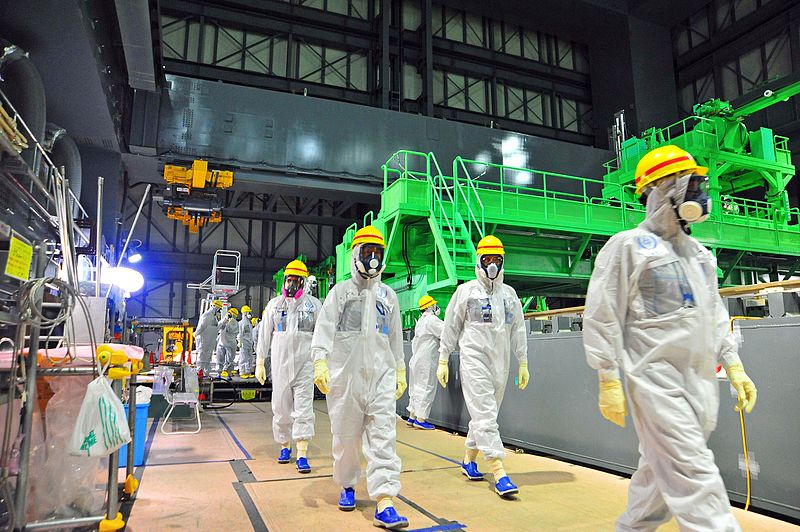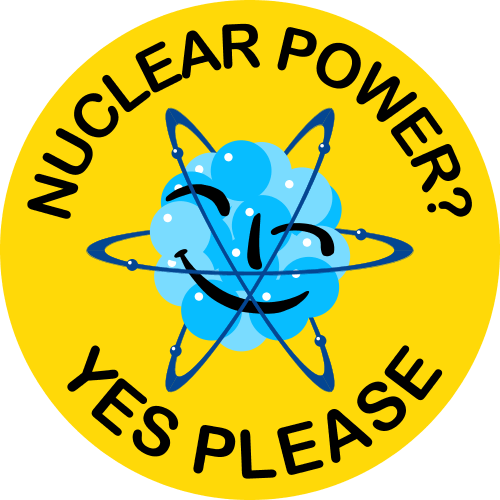David Walters concisely, and passionately calls on leftists and progressives to reconsider their opposition to the use of nuclear generation of energy. The current threat to all species on Earth including humans is obvious. The elimination of near complete reliance on fossil fuel is one of the biggest challenges. But is nuclear power the best alternative pathway? And moreover, even under capitalist state control? I do not ask rhetorically. I honestly am uncertain, and I agree with David that the left must debate this urgent question.
David makes three points, beginning with a “failure of renewable energy” to date. He then labels “two false premises” – equating nuclear weapons with nuclear power energy production; and an unwarranted fear of radiation. My queries fall into four groups.
1) Is the Infrastructure under Capitalist Control Safe Enough?
David states that in the Fukushima event “no one died”. This presumably means from direct radiation. But people did die in ‘excess’ from trauma. Japanese psychiatrists points out that the event:
“produced not only mental health problems such as depression, post-traumatic stress disorder (PTSD), alcohol misuse, and suicide, but also sociopsychological issues such as public stigma and self-stigma of evacuees… more than 80 people have already been officially certified as disaster-related suicidal cases through rigorous decision process” [1]
Perinatal mortality rates in Fukushima rose by 10.6% relative to prior years, consistent with data of Chernobyl effects on Germany. In 2011-12 deaths from pneumonia rose statistically significantly by 2.49 times of prior periods, for 3 months [2]. Finally sudden cardiac deaths rose in Fukushima as well [3].
This is only to say that regardless of direct radiation, other consequences of nuclear ‘mishaps’ occur. It is relevant, since capitalism routinely under-services infrastructure maintenance on grounds of cost-profit. If roads, railways, sewers, bridges, buildings etc. are not safely maintained, why should we assume capital will safely ensure nuclear stations? The Boris Johnson UK government stated:
“The cornerstone of Britain’s plan is an increase to nuclear capacity… up to eight reactors this decade… aiming to increase capacity to 24 gigawatts of nuclear power by 2050, or a quarter of estimated electricity demand.”
Right! The same government that ran the NHS finally into the ground, allows drinking water to be unsafe, and has done precious little to prevent further Grenfell Tower disasters. Perhaps a leftist should conclude that this technology is more suitable for after the revolution under direct democratic control from below?
2) Does Nuclear Offer Indisputedly Better Grid Stability?
Is the alternative to nuclear, a Nero fiddling while the world burns up from greenhouse gases? After all to remind ourselves of the task:
“Every second humans globally consume roughly 15,000 gigawatts (GW) of power, in oil, coal, gas, nuclear, and renewables all added together.1 To put it another way, it means that, on average, we use 15,000 gigajoules (GJ) of energy every second of every day. That is an enormous number, equivalent to switching on 5 billion electric kettles.” [4]
But real issues confront current nuclear alternatives: effects of sourcing and mining for adequate supplies of Uranium; upgrading involves decommissioning older reactors in an expensive way; disposal of spent rods safely requires storage for over 10,000 years. These figures are drawn from Derek Abbott [4], and are in contrast to David’s. Personally I do not know who is right. But such discrepancies need resolution for the left.
The argument that supply is intermittent to the grid is maybe less with nuclear than with alternatives. But clearly even with nuclear it is not a negligible issue. For example, planned shutdowns for rod changes and maintenance. But in addition, perhaps the alternatives are not quite so weak:
“Nuclear lobbyists create a further false dilemma by suggesting renewables make a false dilemma… First, nuclear power is not required because controllable renewable sources (with synchronous generation, such as solar thermal, hydroelectric power, and pumped hydro) already stabilise the grid. It is true that other renewable sources do give rise to grid management issues, but this is bread and butter for grid engineers.” [4]
Abbott states also that in Australia there are adequate plateaus available for pumping of seawater enabling energy storage. Others give copious data that the same holds for Europe – concluding that:
“Conservative technology choices (such as dispatchable capacity for the peak load, grid expansion and synchronous compensators for ancillary services) are not only technically feasible, but also have costs which are a magnitude smaller than the total system costs. More cost-effective solutions that use variable renewable generators intelligently are also available.” [5]
Brown points out that so-called “black-starting” or restarting electricity systems after total blackout is more problematic for nuclear than alternatives:
“Nuclear, is a problem for black-starting, since most designs need a power source at all times, regardless of blackout conditions, to circulate coolant in the reactor and prevent meltdown conditions. This will only exacerbate the need for backup generation in a total blackout. Nuclear is sometimes not used to provide primary reserves either, particularly in older designs, because fast changes in output present operational and safety concerns.”
3) Are There Newer Technologies to Consider?
Let us concede for a moment, that arguments of Abbott and Wilson cited above, are untenable. Even then there are further considerations.
There are indications that even better potential resolutions to current limitations of non-nuclear technology are possible. Consider for instance storage devices and battery technology. For instance ‘supercapacitators’:
“electrochemical energy storage devices … (similar to – HK) rechargeable batteries than electrostatic capacitors. These… are devices of choice for future electrical energy storage needs due to their outstanding performance characteristics.” [6]
Another consideration: most wind generation is currently land based. Moving to off-shore generation has higher likelihood of constancy, but is limited currently to European sites:
“The winds out in the ocean are much stronger and consistent that the winds on land… Many more countries now make use of offshore wind farms since its initial introduction in Denmark… most of the offshore farms are still found in Europe. .. (by –HK) Global Wind statistics in 2014, Europe holds around 90% of these offshore wind farms.”
Dating from the 11th century at minimum, tidal mills used tidal wave power. Generated by the sun and moon’s gravitational pull with the earth’s rotation, in some areas sea levels rise and fall substantial heights. This technology is being further explored.
Finally the matter of ‘fusion’ energy generation versus ‘fission’ energy needs further re-visiting. The author of this guardedly optimistic review points out: “The joke about fusion energy is that it’s 30 years away and always will be”. However there appears to be a definite possibility of translation into reality of fusion based energy generation on a public scale.
Marxists do not dispute that under capitalism the drive for profits over-rides the goals of sane development. Any scientific advance is spun into profitable enterprises, or is warped under capital. Moreover frequently mould-breaking research is frequently underfunded publicly. Short of revolutionary change, there should be more public pressure for increased funding for socially responsible sciences. The last section discusses a potential vehicle for this.
But first the most potentially fraught issue – largely because it is so complex.
4) What Are the Estimated Direct Radiation Effects?
David rightly points to environmental radiation: “Background radiation runs from approximately 1 mSv (milisevert) to 3 mSv globally.”
Even the next statement is likely true, despite a little poetic license:
“There are places on the planet where such natural background radiation is 100 times that number and, no, there are no ill effects on human, plant or animal life because of it.”
Again all this is generally likely true, with caveats around some mining areas; and of course the role of solar UV radiation and cancers is rightly well known. [7]
If I say all this, why do I hold back fully endorsing David’s points about safety?
Returning to Fukishima, David referred to ‘no deaths’, and I teased this out above. But now consider only direct radiation deaths. Some health scientists agree with David:
“In Fukushima, no one has died from radiation exposure, and the UN Scientific Committee on the Effects of Atomic Radiation report in 2013 stated that substantial changes in future cancer statistics attributed to radiation exposure are not expected to be observed, although the committee also noted “a theoretical increased risk of thyroid cancer among most exposed children” and recommended they be “closely followed”. [8]
or:
“The apparent increase in thyroid cancer prevalence that results from screening has caused public concern about the health effects of radiation. However, thyroid cancer is slowly progressive and has a good prognosis and considerable latency. Therefore, attention should be given to the bias of screening effects and possibility of overdiagnosis.” [9]
In reality the “theoretical increased risk of thyroid cancer’ is minimized, and a rather furious controversy arose in Japan – after a report showing: “an excess Incidence Rate Ratio was observed (12, 95% CI = 5.1, 23).” [10]
Or, more simply expressed as an:
“20–61-fold excess thyroid cancer cases, which cannot be explained by the screening effect or over-diagnosis.” [11]
In Japan a huge controversy continues, both sides alleging unethical standards of the other. Tsuda points to one important underlying issue of an arbitrary ‘safe’ radiation level below 100 mSv recommended by the 2007 The International Commission on Radiological Protection (ICRP). He then goes on to attack fundamental concepts of risk by the ICRP – which many have also attacked. Full discussion goes beyond the scope of this article, and it is sufficient to provide selected key references. [12]
Where scientists stand on these issues is intensely mirrored by political beliefs.
5) How to Move Forward?
Undoubtedly David will put me right, on these questions. But this is only one very small part of a dialogue that the left participates in. It seems obvious that many left and progressive sub-specialist expert opinions are required – to sensibly anchor left policies.
One need would be to engage with the myriad environmentalist groups, for instance ‘Friday for Future’ activists. Perhaps such approaches have already happened or are planned. If I only show my ignorance here, I would be delighted to be told of these.
There are some previous models. I am thinking along the lines of the ‘Science for the People’. That always took a broad united front approach in its heyday. It is still functioning of course, see for example Kate Brown (April 4th 2022). Perhaps the journal ‘Climate and Capitalism’ is poised to serve as a modern catalyst.
References:
1. Masaharu M; “Mental Health After Fukushima”; Asia Pacific Journal of Public Health 2017, Vol.29(2S) 36S–46S
2. Shibata Y, “Pneumonia deaths after earthquake and tsunami”; BMJ Open 2016;6:e009190.
3. Körblein A; “Perinatal mortality after Fukushima”; J. Radiol. Prot. 39 (2019) 1021–1030
4. Derek Abbott, ‘Nuclear Power – the game is up”; Australian Quarterly; No.4 2016; 8-16
5. T.W.Brown; ‘Feasibility of 100% renewable-electricity systems’; Renewable and Sustainable Energy Reviews; Vol 92; September 2018, p.834-847
6. Abdul Ghani Olabi; “Supercapacitors as next generation energy storage devices: Properties and applications”; In Energy 1 June 2022; 248
7. “Solar Ultraviolet Radiation, Radon And Fine Particulate Matter Are Largest Contributors To Environmental Burden Of Cancer In Ontario”; 2016 Cancer Care Ontario.. Alberto Modenese; “Solar Radiation Exposure and Outdoor Work: An Underestimated Occupational Risk”; Int J Environ Res Public Health; 2018 Sep 20;15(10):2063
8. Michael R. Reich; “Towards long-term responses in Fukushima”; Lancet Vol 386, Issue 9992, 2015; 498
9. Akira Ohtsuru; “From Hiroshima and Nagasaki to Fukushima 3. Nuclear disasters and health: lessons learned, challenges, and proposals”; Lancet 2015; 386
10. Tsuda T, ‘Thyroid Cancer Detection by Ultrasound Residents 18 Years and Younger in Fukushima,: 2011 to 2014. Epidemiology. 2016;27(3):316
11. Toshihide Tsuda, “Ethical… Promotion of a “100 mSv Threshold Assumption after Fukushima”; Curr Envir Health Rpt (2017) 4:119–129
12. Edward J. Calabrese; “LNT and cancer risk assessment: Its flawed foundations part 1: Radiation and leukemia: Where LNT began”; Environmental Research 197 (2021) 111025, Christopher Busby; ‘Ionizing radiation and cancer: The failure of the risk model’; Cancer Treatment and Research Communications 31 (2022) 100565]




